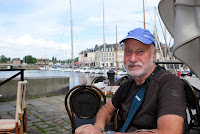I wanted to see the beaches that were used during the D-Day invasion.
Arromanches les Bains faces the English Channel and still has the remains of the temporary harbours that were floated across to assist the logistics of landing so much equipment and so many troops for the invasion by combined Commonweath forces. The beach, Gold Beach – named in WWII, had the remains of these temporary breakwaters – called Mulberry after the military code name.
On D-Day, 6
amphibious divisions supported by 6000 boats and ships and 13,000
aircraft were involved landing 45,000 troops for the initial invasion
that was the start of the liberation of Europe.
The French are
sticklers for tradition and I was thinking that the big lunchtime
close down would have been overtaken by modernity – apparently not.
So in this windswept town there were tourists mooching around in
drizzle waiting for things to open - everything closed, tourist
office, museum the lot. No shared lunch shifts here. I wonder what
the employees do with their 2 hours?
The experience was
completed by a visit to the nearby American cemetery. The Americans
landed at Omaha and Utah beach while the Commonwealth forces landed
at Gold/Sword/Juno beaches. The American cemetery was extremely well
done. Everything was immaculate, the marble crosses and stars that marked the graves were cut as if by laser and laid
out in absolutely straight lines. The crosses were endless. The trees
and lawns groomed to within an inch of their lives. It was all so
beautifully done by the Americans. While it was raining I watched
some audio visuals in the elegantly understated white marble visitor
centre.
That evening we
stayed at our best aire so far, it was behind a manor farm house
,which beside raising dairy cows, had a sideline in tourist
accommodation. Rural outlook, a large gravelled area to park and a
large grassed and hedged area beside us. The neighbouring property
held an ancient stone building with an information board in front of
it describing it as a 14th century chateau. It needed some
major ‘Grand Design Restoration’ but was a working cidery that
also sold Calvados (apple brandy) and Pommeau – apple brandy
diluted with apple juice. So we did our bit for the local economy.
 |
| Stuart cycling toward MSM |
Stuart wanted to
re-visit Mont St Michel, further along the Normandy coastline. It is
an abbey perched on top of an island and looks impressive when you
see it from a distance, like a church floating on water. Forty years
ago we roared across the causeway on Stuart’s Moto Guzzi, parked at
the base and had a wander around. Not much about the abbey and the
cluster of shops at the base selling tat and over-priced snacks has
changed but the approach has.
The island was in
danger of becoming joined to the land by silt collected against the
causeway, so the causeway was removed and replaced by a bridge and
system of barrages and dam to regulate the flow of water. There are
huge 15 metre tides that swirl around the island, some incoming tides
move quicker than a galloping horse across the mudflats. At low
springtide the sea is 15km offshore.
Back to the approach
– 40 years on we cycled to the bike stands, left Howard and Hilda
in steely bondage and walked quite some distance to the new bridge.
On the way back we were lucky enough to get on a push-me pull-you
shuttle bus. (The buses don’t turn around but the driver moves from
one end to the other).
The Loire had once
been an important route for carrying goods but it is an unpredictable
river as we discovered and lost out the transport business as rail
developed.
We filled up on
water before we left – much against Stuart’s desire – “
tankful is the weight of two people you know”, but it was free so
there are two opposing forces in action here.
We had decided to
stay in Saumur in the Loire Valley, again we are at an aire but it is
very large and set among trees, unfortunately the flooding has
caused the mosquito population to explode. They are massive beasts
but quite slow moving.
We have pressed
Howard and Hilda into action to transport us around. There are 800km
of cycle ways in the Loire Valley, the highlight so far is the
troglodyte ride. It was great, the piste went through some restored
underground dwellings and shops that date back the 11th
century. They were carved out of tufa, limestone rock, and were well
below the level where people are living now. These man made caves are
know as troglodyte houses to the locals. Their temperature in the
caves is very cool and the outside air is more humid than an Auckland
summer. I could feel the draughts of cool air that created patches of
mist as I walked past the cave openings.
 |
| An undergrouond cycle path |
 |
| A dismounted cyclist |
 |
| Umbrellas in Saumur |













